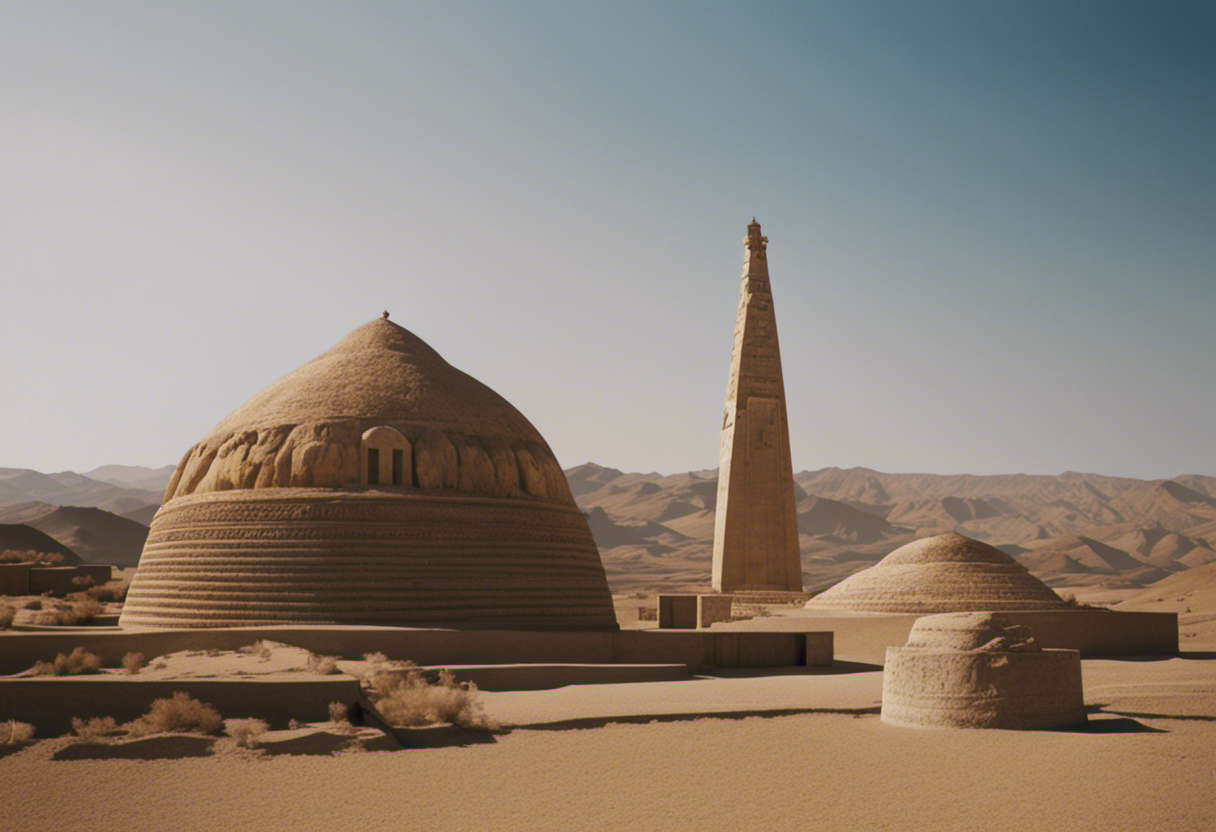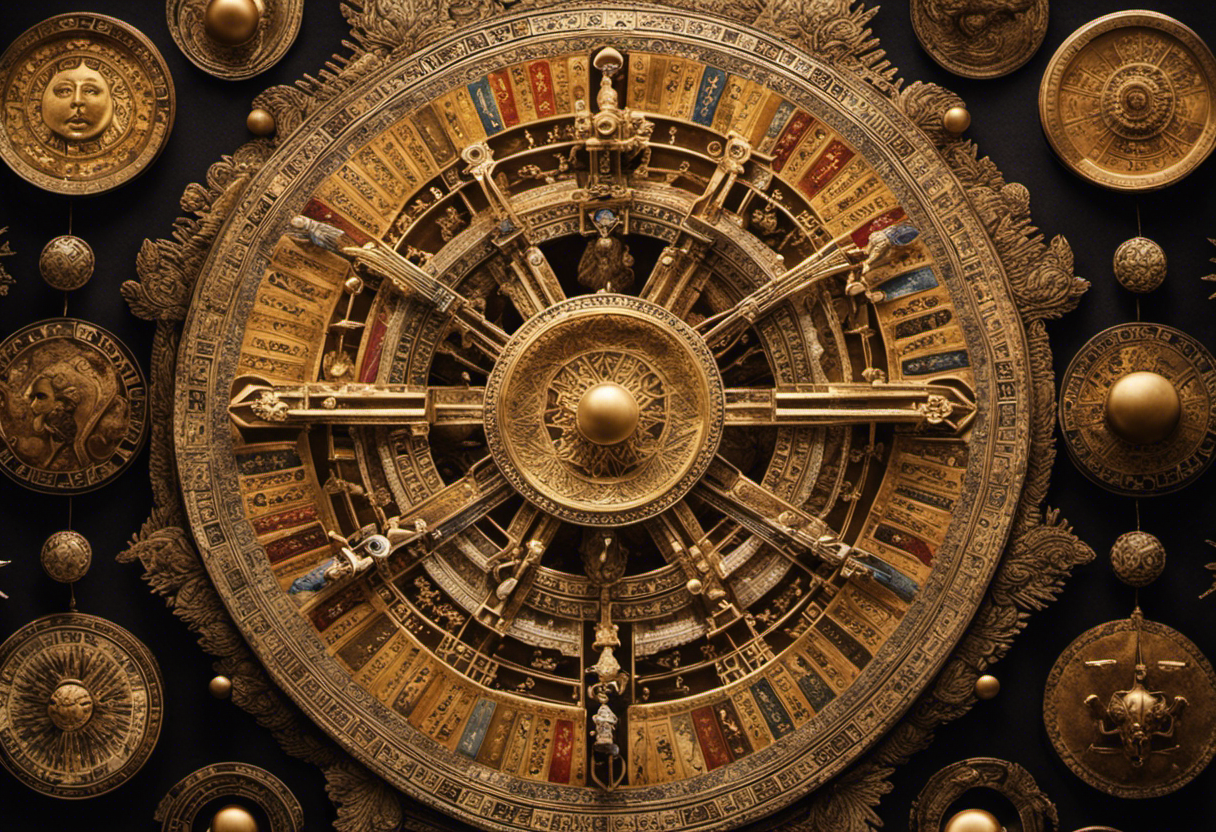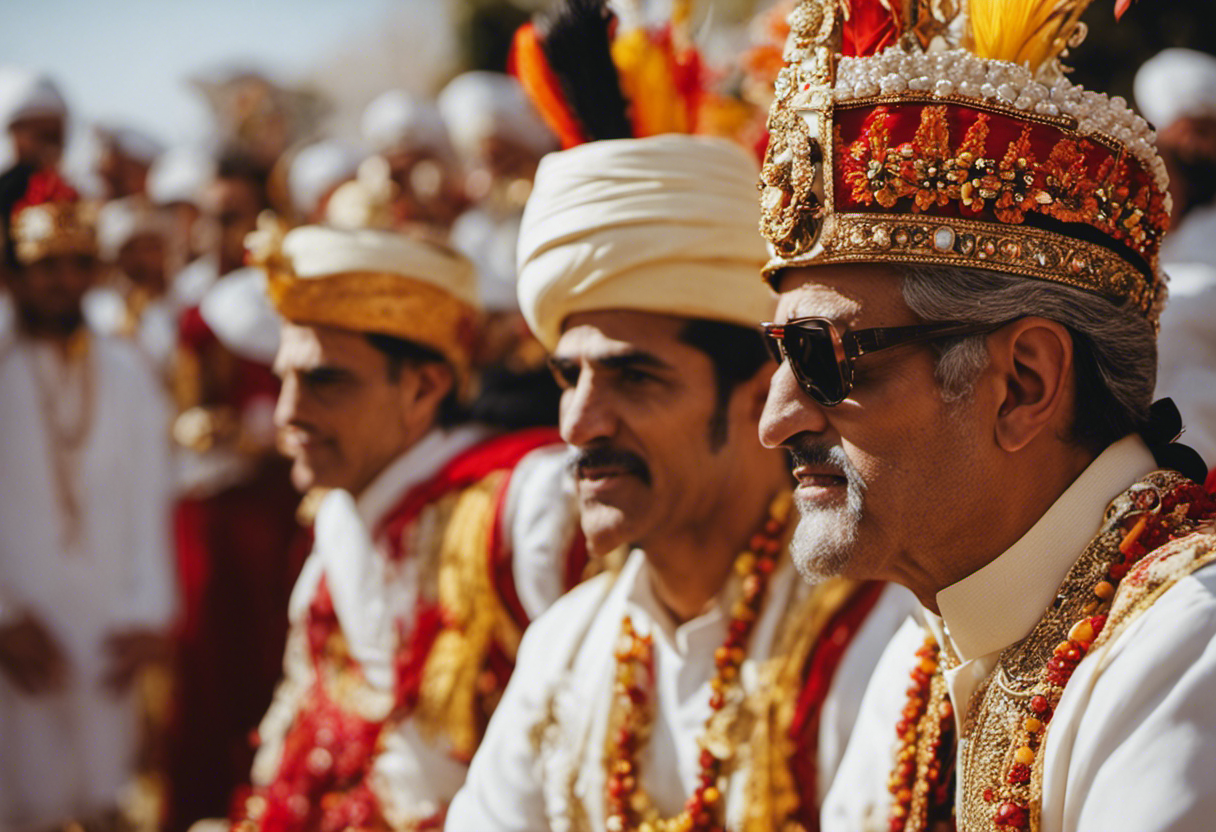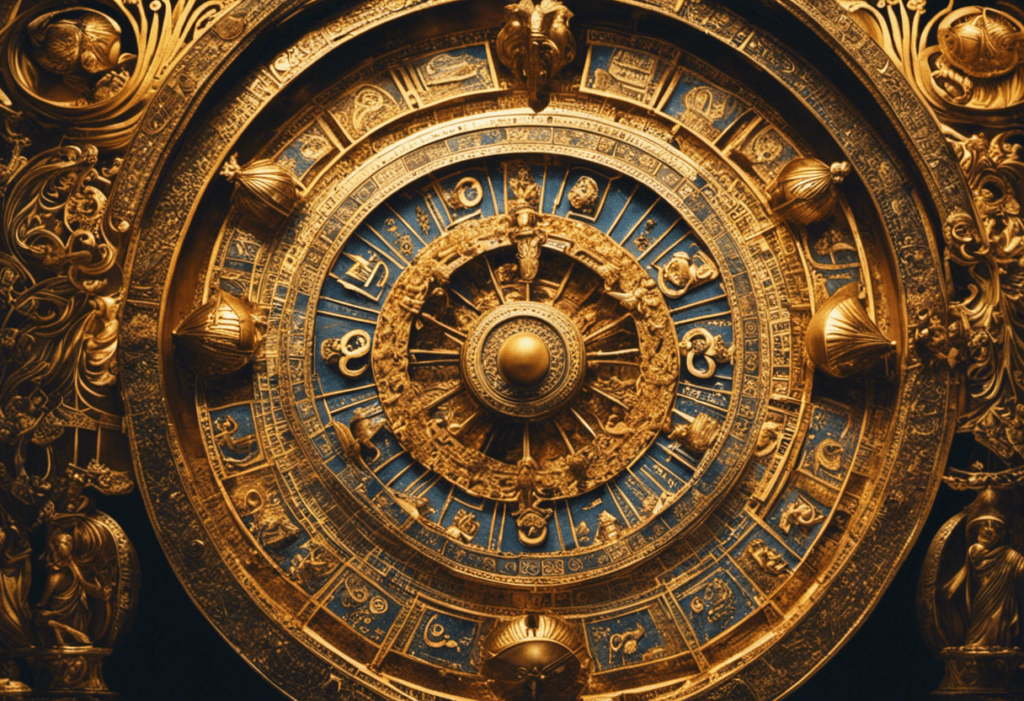The Zoroastrian calendar, like a compass guiding daily life, serves as a fundamental tool for followers of this ancient faith. With a rich historical background and intricate structure, this calendar not only serves as a means to measure time but also plays a significant role in religious practices and cultural celebrations.
This article explores the various components of the Zoroastrian calendar and delves into its practical applications in guiding daily rituals and festivities.
Key Takeaways
- The Zoroastrian calendar was developed during the Achaemenid period in ancient Persia and is based on the solar year, with twelve months of thirty days each.
- The calendar incorporates both solar and lunar calculations, using solar calculations to determine the length of the year and lunar cycles to determine monthly observances and festival dates.
- The Zoroastrian calendar plays a significant role in daily life by guiding daily practices and rituals, determining the timing of festivals and celebrations, and observing seasonal changes to honor the natural world.
- The calendar also has practical applications such as making astrological predictions, guiding agricultural activities, and dictating the timing of religious observances such as prayers and fasting.
Historical Background of the Zoroastrian Calendar


The historical background of the Zoroastrian calendar is essential for understanding its significance in contemporary Zoroastrian practices. The Zoroastrian calendar, also known as the Shahanshahi calendar, has its historical origins in ancient Persia during the Achaemenid period. It was developed by the Zoroastrian priests to regulate religious rituals and ceremonies.
The Zoroastrian calendar has had a significant cultural impact on the Zoroastrian community. It is based on the solar year and consists of twelve months, each with thirty days. The calendar also includes five intercalary days, known as Gatha days, which are considered sacred and dedicated to the recitation of Zoroastrian hymns.
The Zoroastrian calendar not only serves as a means to mark the passage of time but also plays a crucial role in determining religious festivals and observances. It helps Zoroastrians in planning and organizing their religious and social activities, ensuring that important ceremonies and rituals are performed at the right time.
Furthermore, the Zoroastrian calendar fosters a sense of unity and identity among the Zoroastrian community. It serves as a reminder of their rich historical heritage and cultural traditions, connecting them to their ancestors and preserving their unique religious practices.
Structure and Components of the Zoroastrian Calendar


The structure and components of the Zoroastrian calendar are based on a combination of solar and lunar calculations. This unique blend allows for the accurate scheduling of rituals and festivities throughout the year.
Solar Vs. Lunar Calculations
Utilizing precise solar and lunar calculations, the Zoroastrian calendar incorporates both celestial bodies to determine significant events and religious observances. The calendar follows a unique system that takes into account the solar year and the lunar cycle, ensuring the alignment of religious festivals with astronomical events.
Here are five key points regarding the role of solar and lunar calculations in the Zoroastrian calendar:
-
The solar calculations help determine the length of the year, ensuring that festivals and observances occur at the same time each year.
-
The lunar cycle is used to determine the timing of monthly observances and the dates of religious festivals that vary based on the lunar calendar.
-
The interplay between solar and lunar calculations allows for a harmonious integration of both celestial bodies in the Zoroastrian calendar.
-
The calendar’s reliance on precise calculations helps maintain the accuracy of religious observances and festivals.
-
The combination of solar and lunar calculations highlights the significant role of astronomy in the Zoroastrian faith.
Rituals and Festivities Scheduling
Rituals and festivities in the Zoroastrian calendar are meticulously scheduled, considering the structure and components of the calendar system.
The Zoroastrian calendar follows a solar calendar, with the year divided into twelve months of thirty days each, plus five intercalary days at the end to align with the solar year.
This careful scheduling ensures that important religious events, such as the celebration of Nowruz, the Zoroastrian New Year, and other festivals like Mehregan and Sadeh, occur at specific times throughout the year.
However, scheduling conflicts can arise due to the influence of modern life and globalization.
The cultural impact of these conflicts can be significant, as they may disrupt the flow of religious observances and impact the community’s ability to come together and celebrate.
Efforts to navigate and resolve these conflicts while preserving the integrity of the calendar system are ongoing within the Zoroastrian community.
Religious Significance of the Zoroastrian Calendar
A significant aspect of the Zoroastrian calendar lies in its precise calculation of the religious festivals and sacred days observed by the followers of this ancient faith. The Zoroastrian calendar, also known as the Parsi calendar, plays a crucial role in determining the religious practices and cultural traditions of the Zoroastrian community.
Here are five key points highlighting the religious significance of the Zoroastrian calendar:
-
Gahambars: The Zoroastrian calendar marks six seasonal festivals called Gahambars, which are celebrated to honor the elements of nature and promote unity among the community.
-
Navroz: Navroz, the Zoroastrian New Year, is one of the most important festivals in the calendar. It symbolizes renewal and rebirth and is celebrated with feasts, prayers, and cultural activities.
-
Muktad: The Muktad period, also known as the Zoroastrian ‘All Souls’ Days,’ is a time when the community remembers and prays for the souls of their departed loved ones.
-
Yazad Days: The Zoroastrian calendar designates specific days for the veneration of Yazatas or divine beings. These days are dedicated to the worship and contemplation of various virtues and aspects of life.
-
Farvardegan: Farvardegan is a ten-day period in the Zoroastrian calendar when the community pays homage to the fravashis, the guardian spirits of departed souls.
The Zoroastrian calendar not only serves as a tool for scheduling religious events but also plays a vital role in preserving and perpetuating the rich religious practices and cultural traditions of the Zoroastrian community.
Daily Practices and Rituals Guided by the Zoroastrian Calendar
In Zoroastrianism, the daily practices and rituals are closely guided by the Zoroastrian calendar, which plays a significant role in the religious and cultural life of the community.
The calendar not only determines the timing of festivals and celebrations but also holds spiritual significance for various dates throughout the year.
Additionally, adherents of this faith observe seasonal changes and perform specific rituals and prayers to honor the natural world and maintain a harmonious relationship with it.
Festivals and Celebrations
The festivals and celebrations observed by the Zoroastrian community play a significant role in their daily lives, marking important moments in the Zoroastrian calendar. These religious customs and cultural traditions are deeply ingrained in the community, serving as reminders of their history and beliefs.
The Zoroastrian calendar is filled with various festivals and celebrations throughout the year, each with its own significance and rituals. Some of the most prominent ones include:
- Navroz: The Persian New Year, celebrated on the spring equinox, symbolizing renewal and new beginnings.
- Mehregan: A festival honoring the goddess of love and fertility, celebrating the autumn harvest.
- Sadeh: A mid-winter festival commemorating the discovery of fire and emphasizing the triumph of light over darkness.
- Gahanbar: A series of six seasonal festivals, each dedicated to a different aspect of nature and its preservation.
- Jashan-e-Tirgan: A summer festival honoring the goddess of water and rain, celebrated with water-based activities and feasts.
These festivals and celebrations not only bring joy and unity to the Zoroastrian community but also serve as a means of preserving their rich cultural heritage.
Spiritual Significance of Dates
Throughout the year, Zoroastrians engage in daily practices and rituals guided by the Zoroastrian calendar, which holds spiritual significance for the community. The calendar plays a crucial role in shaping the spiritual practices and cultural traditions of Zoroastrians. It consists of various dates and events that are observed by the community. These dates are associated with important religious events, such as the birth and death anniversaries of significant figures in Zoroastrianism.
The Zoroastrian calendar helps to organize and structure the religious and social life of the community. It provides a framework for observing key rituals, including prayers, fasting, and acts of charity. The calendar also helps to create a sense of unity and connection among Zoroastrians, as they come together to celebrate and commemorate important occasions.
In addition to religious observances, the Zoroastrian calendar also includes cultural festivals and holidays that are celebrated by the community. These events provide an opportunity for Zoroastrians to come together, strengthen their sense of identity, and pass on their traditions to future generations.
Overall, the Zoroastrian calendar holds significant spiritual and cultural importance for the community. It guides the daily practices and rituals of Zoroastrians, helping to foster a sense of community and preserve their cultural traditions.
Observing Seasonal Changes
Zoroastrians actively participate in daily practices and rituals that correspond with the seasonal changes observed through the guidance of the Zoroastrian calendar. This calendar, which is closely tied to the agricultural practices and ecological awareness of the community, plays a significant role in shaping their daily lives.
Here are five key aspects of how Zoroastrians observe seasonal changes:
-
Festivals: Zoroastrians celebrate various festivals throughout the year, such as Navroz (New Year) and Mehregan (Harvest Festival), which align with the changing seasons and agricultural cycles.
-
Prayers: Zoroastrians offer prayers and perform rituals to express gratitude for the abundance of nature and seek blessings for the success of their agricultural endeavors.
-
Seasonal Foods: The Zoroastrian calendar influences the types of foods consumed during different seasons, reflecting the availability of fresh produce and the nutritional needs of individuals.
-
Environmental Stewardship: Zoroastrians are encouraged to practice ecological awareness by actively engaging in sustainable farming practices and promoting the preservation of natural resources.
-
Community Engagement: Seasonal changes provide opportunities for Zoroastrians to come together as a community, working collectively towards common goals and fostering a sense of unity.
Festivals and Celebrations in the Zoroastrian Calendar


In the rich tapestry of the Zoroastrian calendar, various festivals and celebrations mark the auspicious occasions within the faith. These festivals and celebrations play a significant role in the lives of Zoroastrians, providing a sense of identity, community, and spiritual fulfillment. Zoroastrian festival customs and holiday traditions are deeply rooted in ancient rituals and beliefs.
One of the most important festivals in the Zoroastrian calendar is Nowruz, which marks the beginning of the New Year. Celebrated on the spring equinox, Nowruz is a time of renewal and rebirth. Zoroastrians engage in various customs during this festival, including the setting of a haft-sin table, which consists of seven symbolic items.
Another significant festival is Mehregan, a celebration of love and friendship. During Mehregan, Zoroastrians come together to honor the divinity of love and express gratitude for the blessings in their lives. Traditional customs during this festival include the exchange of gifts, wearing colorful clothing, and participating in communal feasts.
These festivals and celebrations serve as a way for Zoroastrians to connect with their faith, strengthen community bonds, and pass down traditions to future generations. They are a testament to the rich cultural heritage and enduring spirituality of the Zoroastrian community.
Practical Applications of the Zoroastrian Calendar in Daily Life


The practical applications of the Zoroastrian calendar in daily life encompass a wide range of activities and traditions that uphold the religious and cultural values of the community. This ancient calendar, which is based on the movement of the sun and the moon, plays a crucial role in guiding the daily lives of Zoroastrians.
Here are five key practical applications of the Zoroastrian calendar:
-
Astrological Predictions: The Zoroastrian calendar helps in making astrological predictions, which are believed to provide insights into the future. Zoroastrians consult astrologers to determine auspicious dates for important events such as weddings, business ventures, and religious ceremonies.
-
Festivals and Celebrations: The Zoroastrian calendar determines the dates for various festivals and celebrations throughout the year. These festivities, such as Norouz (Iranian New Year) and Mehregan (Festival of Autumn), are important occasions for Zoroastrians to come together, strengthen community bonds, and express their religious devotion.
-
Agricultural Activities: The Zoroastrian calendar also guides agricultural activities. It helps farmers determine the most favorable times for sowing seeds, harvesting crops, and performing other agricultural tasks, in harmony with the natural cycles of the seasons.
-
Religious Observances: The Zoroastrian calendar dictates the timing of religious observances such as prayers, rituals, and fasting. It ensures that Zoroastrians adhere to their religious obligations at the appropriate times, fostering a sense of spiritual discipline and devotion.
-
Commemorations of Ancestors: The Zoroastrian calendar designates specific days for commemorating ancestors and performing rituals in their honor. These occasions allow Zoroastrians to honor their forefathers, maintain a connection with their roots, and express gratitude for the blessings of the past.
Conclusion
In conclusion, the Zoroastrian calendar plays a significant role in the daily lives of Zoroastrians. Its historical background, structural components, and religious significance shape various practices and rituals followed by the community.
The calendar also guides the observation of festivals and celebrations throughout the year. With its practical applications, the Zoroastrian calendar serves as a valuable tool for organizing and planning daily activities.
An interesting statistic to note is that there are currently over 120,000 Zoroastrians worldwide, showcasing the continued relevance and importance of the calendar in their lives.


